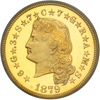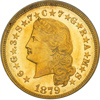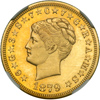
|
Sale 51
Pre-Long Beach Coin and Currency Auction
| Lot |
Photo |
Description |
Realized |
Lot 1431 |
 |
1879 $4 Gold. PCGS graded Proof 65 Deep Cameo. An exciting Gem Proof ablaze with mirror surfaces against delicately frosted devices thus the "DCAM" designation by PCGS. Approximately 425 or so struck. Talk about a tidy, fully qualified Gem Cameo Proof! The present piece stands head and shoulders above most examples in its grade that have sold in recent years. Among the finest Proof 65s graded by PCGS, as the observations described below will tell. There are many factors propelling it to the head of the line. This includes the exemplary eye appeal, well above average in the present instance, the detail in the main devices, and the natural vibrancy from long years in an hygenic environment free from contaminants. The piece displays a bright yellow-gold intensity. It really electrifies the numismatist "genre" in any Type of this denomination. The $4 Flowing Hair Stella is ideal for a U.S. gold Type set, or simply as a single, stand-alone Great Rarity to include in a portfolio of gold and related coins. Again, without mincing words, this is one of the most attractive Proof 65s we have been privileged to auction, considering the fairly large number of gold rarities that have passed through our sales.
The $4 Stella was promoted by John A. Kasson, United States minister to Austria in 1879. Kasson chaired the Committee of Coinage, Weights, and Measures earlier in his career and was an advocate of a metric coinage that could be used universally throughout Europe and the Americas. Kasson's proposal was forwarded to the U.S. Mint bureau with the $4 Stellas the result. The Philadelphia Mint's two engravers, Charles E. Barber and George T. Morgan, were responsible for designs of the $4 gold piece. Barber made this prototype of Liberty with loosely flowing hair, known quite naturally today as the Flowing Hair type. Morgan's Liberty has her hair in a coil and coiffed, the Coiled Hair type. Patterns in gold (and other metals) were struck in 1879 and again in 1880, but none were ever made for circulation.
Ever since the time of issue, these beautiful and fascinating $4 Stellas have created hours of lively discussion in numismatic circles for the better part of a century and a quarter! Pop 9; 2 in PR-66 DC and 1 in PR-67 DC (PCGS # 98057) .
Estimated Value $190,000 - 200,000.
View details and enlarged photos
Check results on similar lots
| Unsold |
Lot 1432 |
 |
1879 $4 Gold. Flowing hair. PCGS graded Proof 65. A magnificent Gold Stella with delicate golden overtones on both sides. Approximately 425+ specimens minted. It doesn't mean a thing, but there is a small toned spot at UN(UM) on the reverse. A vivid gleaming gold specimen with some wonderful accents of color in the fields and on the devices of both sides. Lightly cameo frosted motifs receive their support from the fine reflective fields which wag the light back and forth that strikes its surface, and accounts for the a pleasing contrast plus the high grade it deserves. The coin is a nicely struck one for the issue, with only a trace of soft detail in some of Liberty's hair curls above the temple. Better still, few of the usual mint-caused striations are found at the centers (these often plague the case on Stellas). Surfaces are virtually pristine. Devices, the same. The grade captures the spirit of this coin's originality. All in all, we are pleased to offer to bidders a marvelous opportunity to acquire a Gem Proof example of a rare and widely admired gold coin. Pop 26; 28 finer in 66 (PCGS # 8057) .
Historic note about the confusing Judd & Pollock numbering schemes: Judd called all 1879 Flowing Hair Stellas struck in gold "J-1635." Later research developed the theory that the gold Stellas were produced in two different finenesses, to which Pollock assigned different numbers. The first, P-1832, represents pieces struck in 85.71 fine gold, 4.29 fine silver, and 10.0 fine copper. It is believed that these were the first 15 struck. Later, after interested parties requested samples of the new Pattern design, some 400 or more additional pieces were made on .900 fine gold planchets, those being designated P-1833. Students of the series find it difficult to distinguish between them other than by means of expensive non-destructive testing; the weights do differ slightly for the two metallic alloys.
Estimated Value $170,000 - 180,000.
View details and enlarged photos
Check results on similar lots
| Unsold |
Lot 1433 |
 |
1879 $4 Gold. Coiled hair. NGC graded Proof 63. A Classic American Rarity that always causes excitiment when offered for sale. Only 12 known. This particular specimen shows horizontal striations on the obverse through Liberty's hair and we also note that the reverse die is slightly rotated counter clockwise by about 15 degrees. Identifiable by a small lintmark just by Liberty's hair braid which is useful for tracing the provenance. There is also a short lintmark the links the 1 in the date to the neck point above. A very rare and impressive coin for the advanced numismatist.
Reflective, Prooflike bright greenish yellow gold fields sport cameo contrast from the devices. A few minor hairlines and other minute blemishes are evident. On the reverse there is a small pit in the planchet close to the dentils and right of the final A of AMERICA, in addition to this there are three short lint marks surrounding that same letter. It is suggested that just 10 examples were struck, although a few more may have been made unofficially given the recorded population data. It has not known for certain who designed the star-reverse die for all four-dollar gold coins. Obverse: large date logotype that appears identical to the Flowing Hair Stellas. Reverse die: D in UNITED is widely doubled, the original placement above final position and most prominent on the post of that letter.
The coiled hair design was George T. Morgan's landmark design. It incorporates a bust of Liberty with her hair in braid bunched at the back of her head with a small crown inscribed LIBERTY above her forehead. The obverse inscription matched the Flowing Hair design and stands for 6 grams of gold.3 silver and .7 copper, which was the metric alloy, these being America's second metric coins after the Shield nickel or 5-gram five-cent pieces of 1866-1883. It is believed that most of these were struck using standard mint 90 percent gold and 10 percent copper. This particular specimen has appeared in several auctions over the years.
According to the Heritage sale description of this piece earlier in the decade, "In the Report of the Director of the Mint for fiscal year ended June 30, 1867, Henry R. Linderman discussed the concept, stating that problems included some countries emphasizing gold and others silver. The three principal moneys of the world were the American dollar, the British pound sterling, and the French franc. Linderman observed that it would be necessary to bring them into harmony. He foresaw that a coin of about the $5 denomination would be useful, but that it would have to be made lighter or heavier in certain countries. As an example, if the weight of the British sovereign were to be used, then the American $5 gold coin would have to be made lighter, causing a legal problem in America with regard to the fulfillment of contracts payable in gold coins of specific standard. He recalled that this ground had been covered before, and that the Mint had written to the Department of the Treasury on December 31, 1862, and that nothing new had been learned since."
"It would be important to also note that many powers were at work trying increase their sales of silver to the mints, as silver as a metal had little industrial value and was almost exclusively for coinage. Reps. Richard P. "Silver Dick" Bland, John Adam Kasson and William Darrah Kelley had high hopes of promoting a new international coin which would use some of their abundant silver. Of course, the mints would purchase their silver at artificially inflated prices. Their prodding resulted in the metric alloys proposed in these Stellas. One can only imagine the consternation at the Philadelphia Mint that now had to alloy gold with additional silver and copper, and these $4 stellas had to be prepared using alloys different from all other gold coinage of their day." Pop 3; 4 finer with 2 in 65, 2 in 66 (PCGS # 8058) .
Estimated Value $275,000 - 300,000.
Ex:Bowers and Ruddy, 5/1972: 521 $29,000; Sotheby's, 9/1982: 250 $61,600; Stack's, 10/27/1983: 57 $74,800; Bowers 8/1995: 307 $137,500; Heritage 9/1998: 7105; Heritage 1/2005 FUN.
View details and enlarged photos
Check results on similar lots
| Realized
$304,750 |
|
|